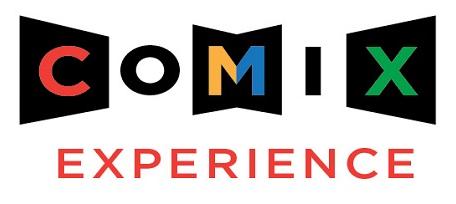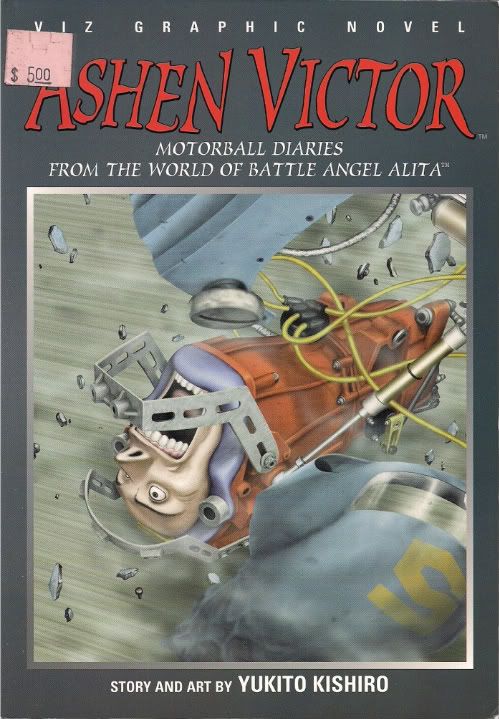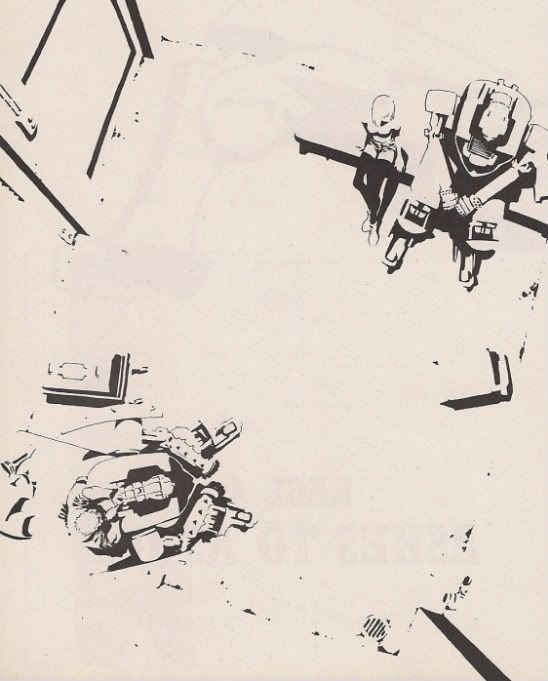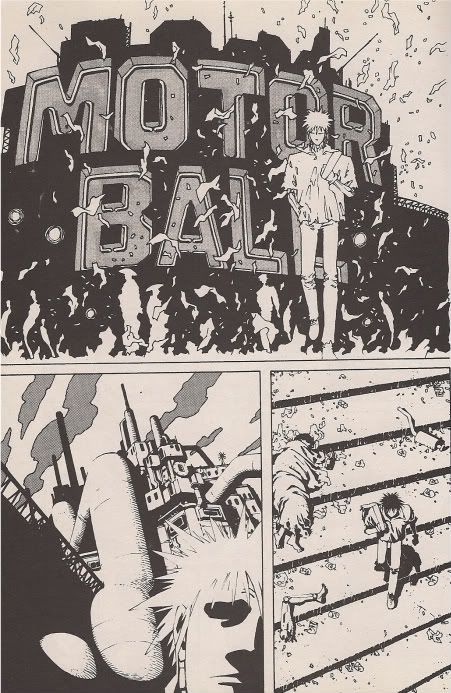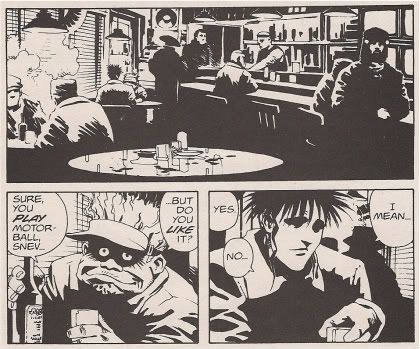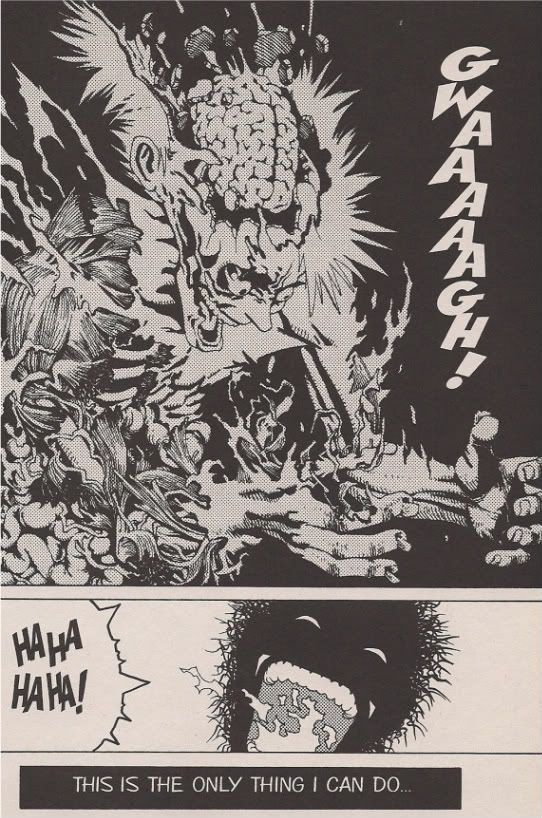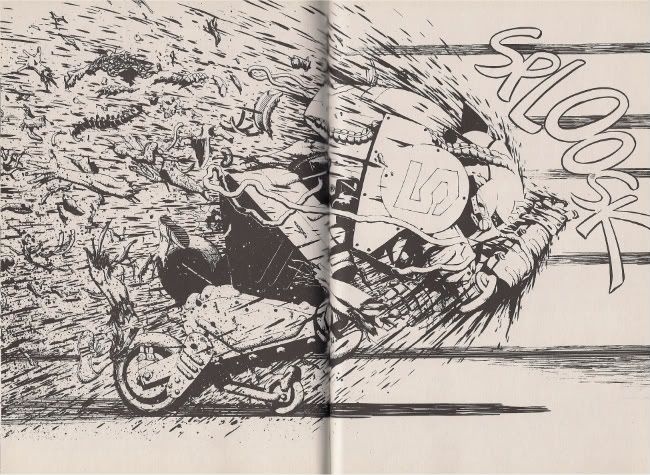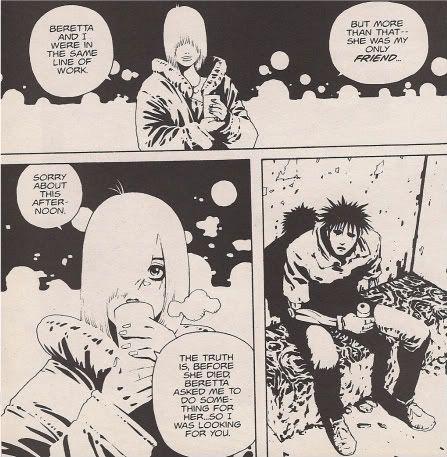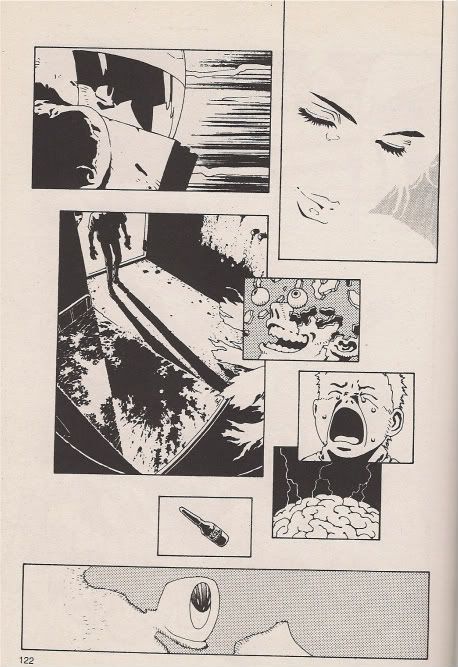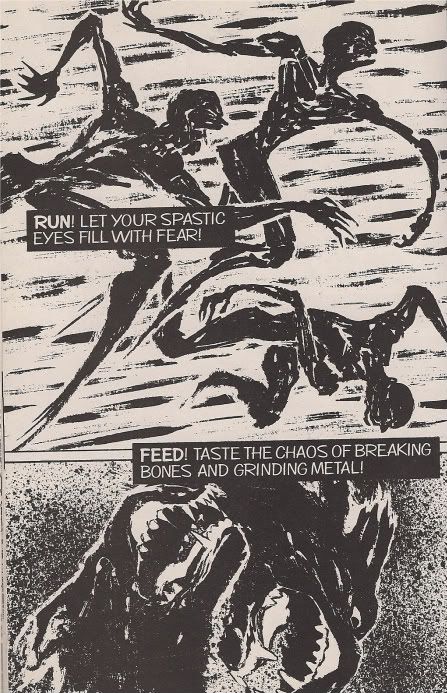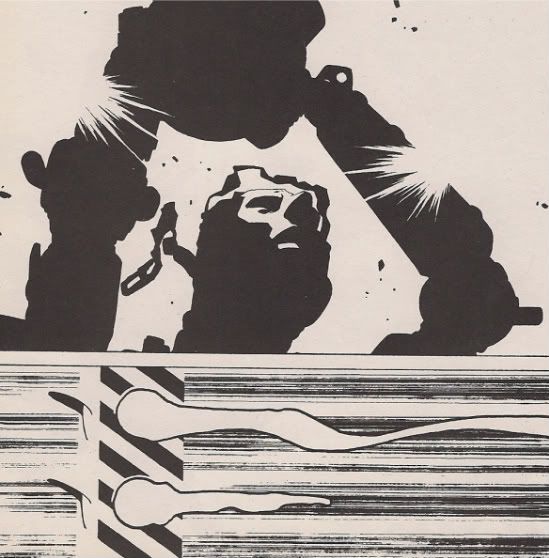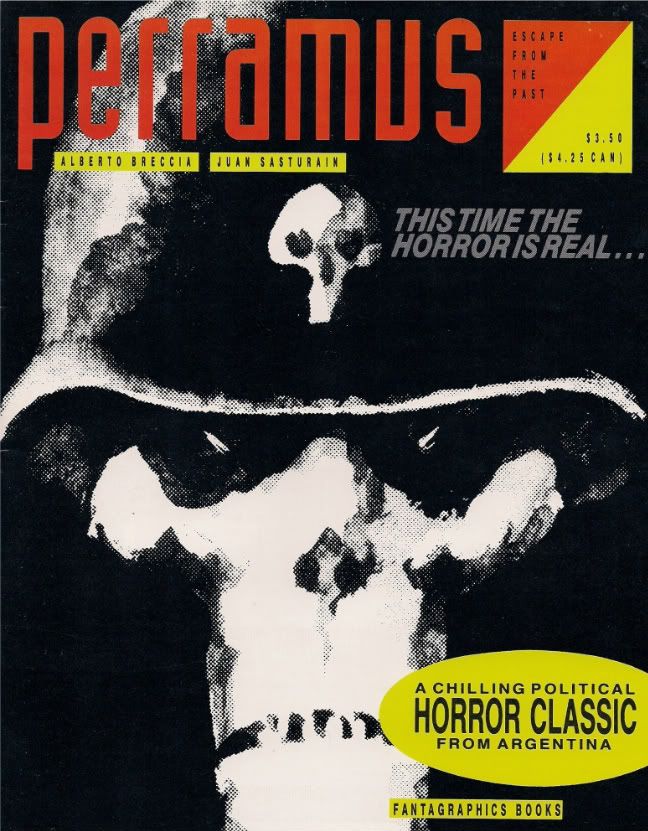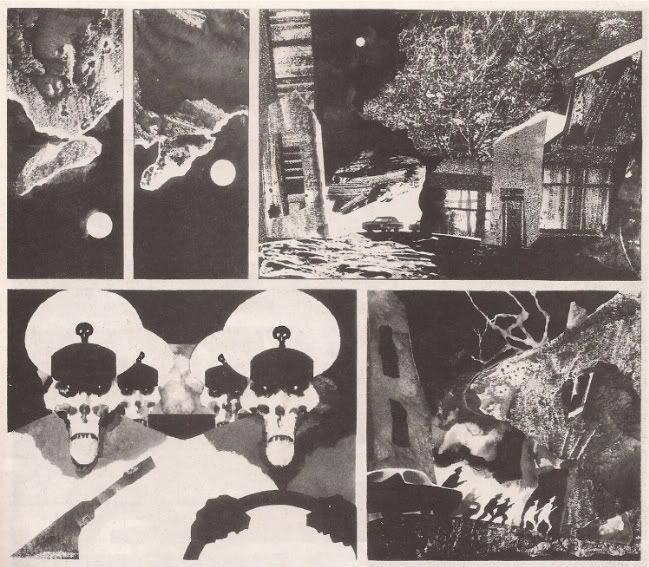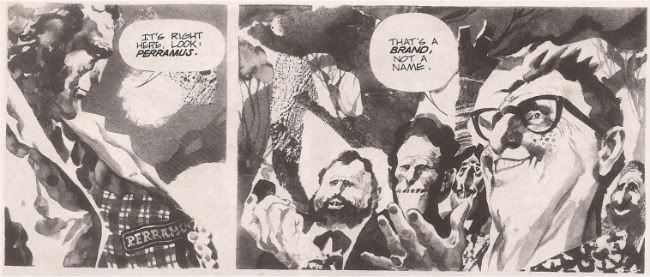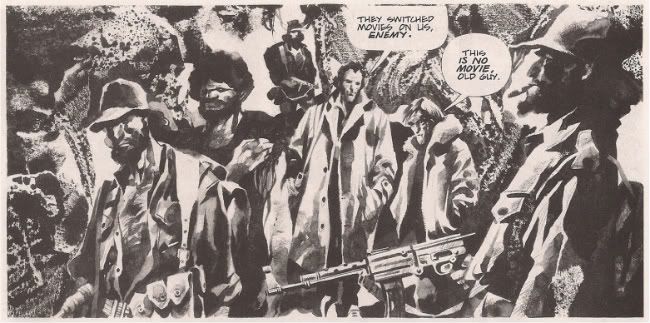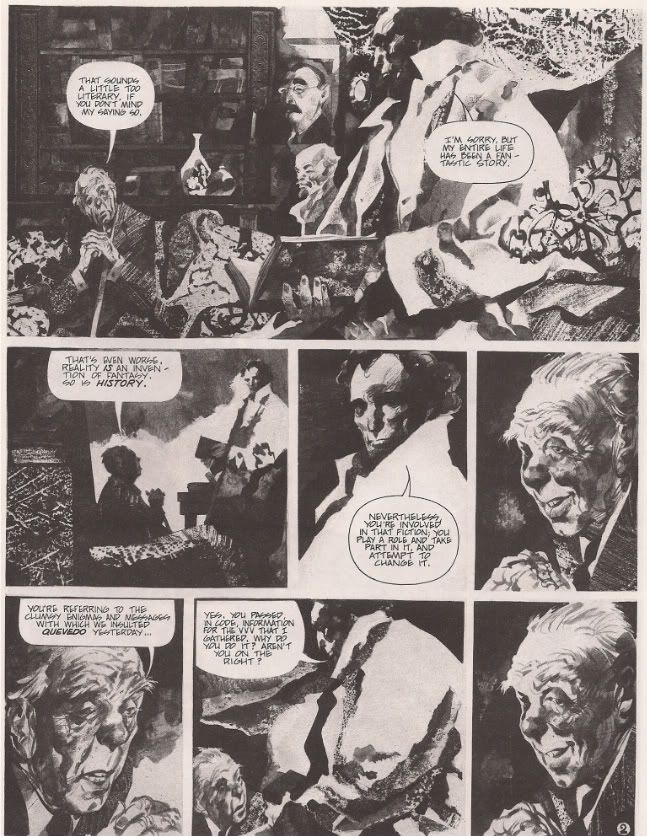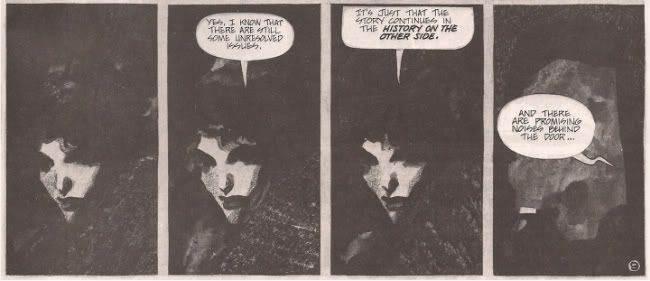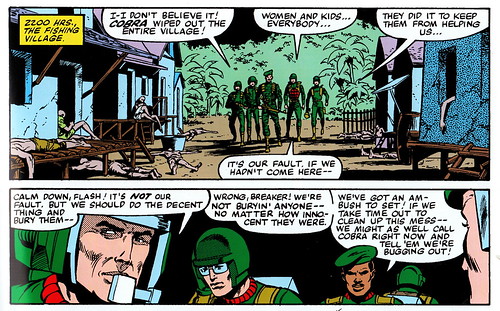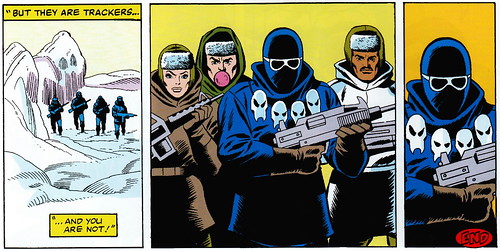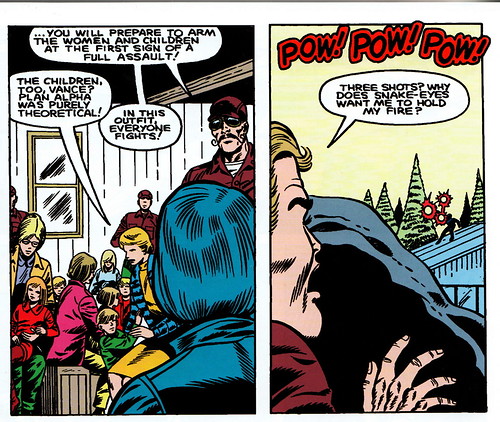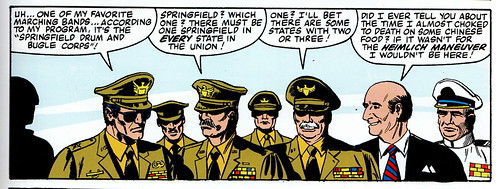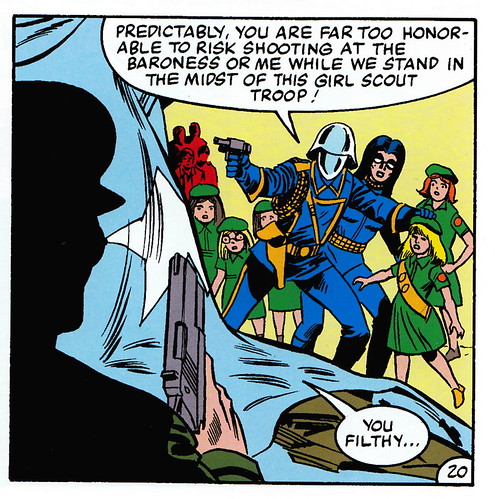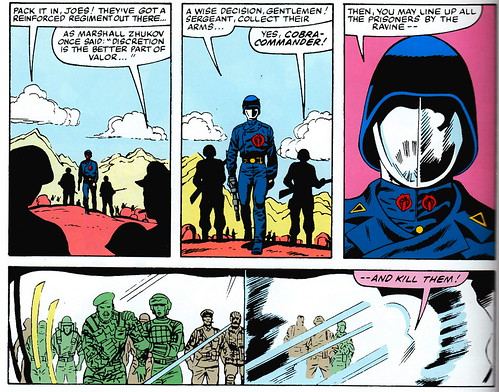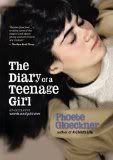
 (being the final installment of an 18-part series of posts concerning each and every book released as part of the DC/Humanoids publishing alliance, 2004-05; index of posts here and here)
JM: Hello all! This is Jog, speaking in the exotic dialect of italics.
(being the final installment of an 18-part series of posts concerning each and every book released as part of the DC/Humanoids publishing alliance, 2004-05; index of posts here and here)
JM: Hello all! This is Jog, speaking in the exotic dialect of italics.
TS: I'm Tucker, I roll with No Formatting. This is where Jog and I will talk about the Chaland anthologies, the school of the clean line, diacritical markings, and how it's fun to google By The Numbers and find out the only other person who talked about online happens to be Evan Dorkin.
JM: All right, I'm getting the hang of it. Talking to other people, I mean.
TS: Portions of this were written while I was waiting to download a pornographic version of Silence of the Lambs. If I seem unduly excited about Yves Chaland, that's why.
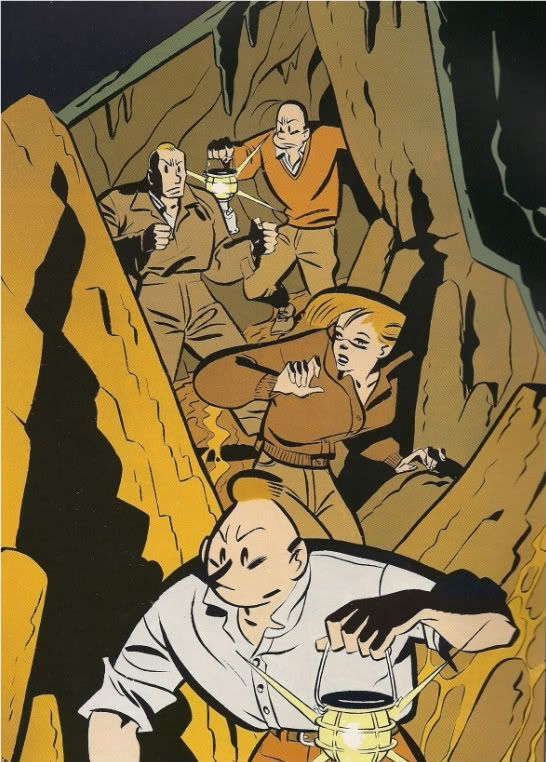 I. Associated Humanoids
I. Associated Humanoids
TS: My first question is "Why do all these books, Jog?" You were the one who came up with the idea, although there was a sort of weird coincidence in that Matthew Brady (not the Matthew Brady Jodorowsky yelled at, the Warren Peace one) and I were having a little debate about whether or not it mattered if comics companies make good business decisions, and DC/Humanoids was stuck in my head as proof positive of what can happen to good material when it's horribly mismanaged. But yeah: all of them? What's up with that?
JM: Two reasons spring to mind right away:
1. I love starting big projects and only finishing after extravagant delays. It's a fetish, a physical thing, and for that I thank you.
2. It's a strange window, this Humanoids thing. You know? Like, the publisher's status these days; it's mainstream, mostly. It's a mainline publisher, putting out populist books, and we don't see all that many of those in North America. Not from France; manga, sure, but that's tapped into a desire for popular entertainment of a different stripe than what was readily available before. French-language comics haven't done that, but there's obviously interest in the 'art' comics world, so I think there's a hovering notion of French-reading Europe as a haven for arts-first comics, but some of that's just what we can see through the framing of language, of publishing activity.
I mean, obviously you can argue the French-reading environment is more amenable to certain genuses of sophistication, sure, but then you've got the Heavy Metal problem. That was the first germ of this idea for me. Christ, germs and problems - I'm a psychological ruin, Tucker. What's it like watching a man come apart via Google Docs, by which I mean face-to-face communication that's totally real?
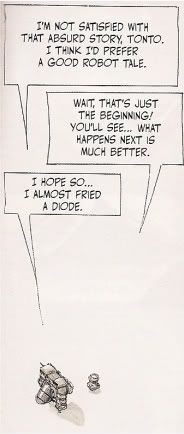 (From The Metabarons: Alpha/Omega)
But yeah, Heavy Metal. It's around every month, on your friendly local chain bookstore newsstand, right next to Classic Rock Presents: Prog or The Best American Penthouse Letters 2008, and you look inside and *holy shit* it's French comics! Album-length French comics, most months, sometimes twice in a month if it's a special, and a lot of them aren't art comics, you know? But there present all the time, and obviously they're coming from somewhere; it's a somewhere we don't see, but it's not inconsiderable.
(From The Metabarons: Alpha/Omega)
But yeah, Heavy Metal. It's around every month, on your friendly local chain bookstore newsstand, right next to Classic Rock Presents: Prog or The Best American Penthouse Letters 2008, and you look inside and *holy shit* it's French comics! Album-length French comics, most months, sometimes twice in a month if it's a special, and a lot of them aren't art comics, you know? But there present all the time, and obviously they're coming from somewhere; it's a somewhere we don't see, but it's not inconsiderable.
And Les Humanoïdes is special in that regard; that's the place Heavy Metal came from -- in that Métal Hurlant was the inspiration -- which also served as a focal point for the French mainstream. Moebius, Druillet - those guys were actually interested in pushing boundaries in more than just the "extra blood; naked" sense. There was more violence and nudity, yeah, but there were metaphorical, philosophical, improvisational aspects too; I really really don't want to oversell their influence, but they were part of something, which was on the a cutting edge of the form for a while, visually, literarily, etc. There were ideals and longings.
Time passes, then - the publisher survives, changes hands, the scene changes, everything changes. Humanoïdes is part of the mainstream. Heavy Metal is part of the mainstream (they were always owned by different people, the National Lampoon people at first, but bear with me), a North American mainstream that it played a part in too, since it arrived right in the bridge period between underground comics and 'alternative'-comics-as-a-force, in the young Direct Market. Come 1999, and Humanoids is founded as a North American concern. The environment is totally fucking different, nobody is fucking involved in comics in 1999 that doesn't want to be there because it's a complete mess, it's hard to get a foothold; it's totally new, but new in a way that Humanoids' French counterpart had a tiny hand in. And the French stuff is different too; like, The Metabarons isn't The Airtight Garage, you know?
So there we have history looking to repeat itself, but it's really two brands of mainstream that don't match. It's pamphlets vs. albums, and a hundred other things. Humanoids goes through all these ideas to fit in (when less than a quarter of a century prior they just waltzed in and picked partners) - releasing pamphlets, breaking storylines up, carrying some albums over wholesale, multi-album trade paperbacks, new 'modern' coloring, hiding all the dangerous bits of the body that take me to Bad Time, reviving a magazine in comic book form and calling in people from around the world... they tried everything!
Suddenly, 2004: oh my god, it's DC! And Mainstream A tries to partner up with Mainstream B, and suddenly the window breaks open, and we can see a huge glob of what Humanoids became. Or, it was possible to see, at least, since there wasn't a ton of press and they put out a shitload of stuff, more than anyone could probably keep up with, so the bigness of it ironically wound up hurting its visibility. Some people were talking -- Warren Ellis and Matt Fraction (I'd link but artbomb seems to be dangerous these days, per Google) were on top of the Metabarons, the Bilal stuff -- but despite the internet being around there wasn't a lot of comprehensive coverage, not like you'd find for every DCU title. I'm counting myself in with that, by the way - I was blogging, writing about comics, and I covered exactly one of those books (François & Luc Schuiten's The Hollow Grounds).
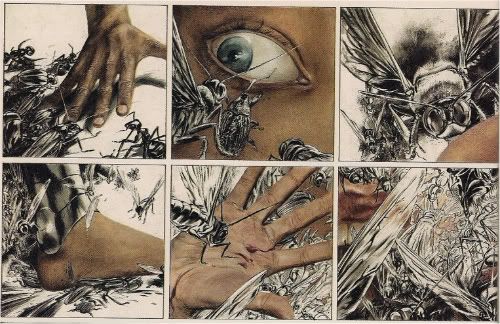 (From The Hollow Grounds)
(From The Hollow Grounds)
By 2005 it was gone; the deal was sunk. Humanoids vanished until this year, teamed up with DDP. That's five years, and I was looking around, you and me were talking, we'd wanted to work together on something. I think our second best option was doing the first 20 issues of The Savage Dragon, using Olav Beemer's letters to Erik Larsen as holy writ, an involuntary third critic reporting from 1993, for our reaction - time-travel criticism!
Then you started mentioning Yves Chaland; I'd looked at some of his stuff, Humanoids had released some, then DC/Humanoids reprinted it and put out more, and I'd written him off totally as a nostalgist bore, and you got me to actually read further than the first one and a half stories, and whoops - he's kind of a genius! And the type of genius with one foot in the early days of Franco-Belgian comics, and the other in the early Humanoïdes days; it was perfect, and it really provoked me, and I wanted to see what else was hiding away in the DC/Humanoids catalog.
There was something going on about criticism too. I don't think it's unfair to say a lot of online comics criticism is devoted to pamphlet-format serials/ongoing series, which isn't illogical, since the steady output of stuff facilitates discussion and commentary, new topics, new questions. But I think that also marks the conversation as perpetually current, which spills over to talk about standalone books and things. And the internet doesn't have to do that, in my opinion, because it doesn't have to answer to investors or subscribers or sponsors, and there's no risk of someone picking you up off the stand and going "holy hell, these Penthouse letters are all from 2004, I'm not turned on by John Ashcroft anymore, sheesh," which I think is maybe the expectation of a print publication, unless it's specifically dubbed a forum for reflection or whatnot. Or, you know, maybe there's a 'old times' slot, but even then you've got space to worry about; if you're running a zine, there's spatial concerns, getting it out to people.
On the internet, there's none of that. Ideally, people can easily access a huge amount of content, which there's space for. Yet I couldn't find a lot of work related to even something sorta-mainstream like DC/Humanoids (maybe more hybrid-mainstream, which arguably defeats the whole 'mainstream' idea) and I thought: hey! Times have changed! These books are pretty cheap, used, so they're untethered from the financial constrainst of new releases (which is another topic entirely), and there ought to be something going on with the whole sick crew. There's stuff here. Interesting stuff.
And since you'd gotten my mind on the topic, I realized it was the perfect idea for our collaboration. I know you have a history with these books too.
TS: I would hate to read blogs if it was all just up-to-the-minute "this just happened" kind of coverage. The internet provides this forum where there's a mentality that everything needs to be talked about by everybody, and I just can't be bothered. Sure, it might give me the opportunity to write about The Bad Girls Club, which I really enjoy doing, but the idea that everybody needs a Flash: Rebirth review within a week of it coming out--really? Why? You can taste it when somebody is online and feeling like they "have" to have an opinion because all the big sites/bloggers are expressing one. Like that Marvel Divas cover thing, or whether or not the single issue sales for DMZ are accurate: I don't have an opinion, and just because there's a forum to put one out there doesn't mean I need to take part. I don't walk down the street and jump into every fucking conversation I see strangers having, and I don't talk about the movies I like with the people in my office who won't shut up about Hotel For Dogs. There's got to be a reason to talk about something, or else it's just not going to be interesting to read about.
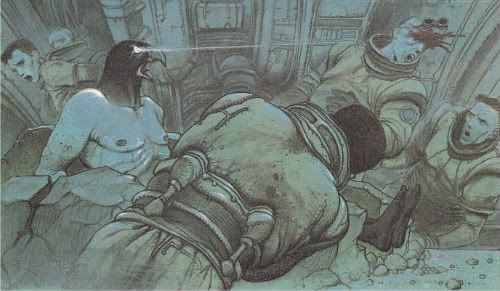 (From The Nikopol Trilogy)
(From The Nikopol Trilogy)
Doing something like this--a silly, labor intensive slog through a bunch of great-to-awful comics, all of which aren't quick throwaways--there's got to be a real desire to do it. Otherwise you're not going to finish it, and if you do, it's going to be unreadable. When you brought it up, my first thought was "That's going to be difficult", not just because the style, story and quality had quite a range even in the portion I'd already read, but also because there's this mystique (that I subscribed too, although I'm not so sure I believe it anymore) that European comics were just categorically "deeper" than the stuff I normally write about. I think that stems a bit from the way they get treated in America, that they're first and foremost foreign material, material that comes from a different type of publisher and artist relationship than the one I've spent years immersed in.
At the same time, I don't think I came to this with the sort of background you have--I don't know that I've ever really paid much attention to Heavy Metal, my initial experience with Moebius probably was that scene in Crimson Tide, and I'd always thought of Jodorowsky as a filmmaker, first and foremost. But as when we got into it, I realized that was sort of an interesting point: most of the people coming at this work, or at least a good portion of them, would have explored the Humanoids line the same way when DC started releasing the books. They probably knew more than I did, most people do, but it wasn't like these reprints were showing up because of reader demand. Also, I knew in advance you were going to handle The Incal, and I found that book particularly intimidating to talk about.
My history with these books, which I touched on a little bit when I reviewed Bilal, was pretty simple: I saw The Horde and Hollow Grounds, and I liked the idea that I was finally going to get to see some non-Tintin/Asterix European stuff. I wasn't a blogger person then, so I had more free time to jack off to weird shit. I just signed up for the series on a whim, and I stuck with that for a good six months at least, maybe longer. I'd go into the comics shop, they'd have a Humanoids trade pulled for me, I'd take it home and read it or not. Some of these--the conclusion of Son of the Gun for one--I had never made the time for, and the only ones I'd ever even played at writing about was a sarcastic "go fuck yourself" with The Technopriests. At the time, and even more so now, I was struck by how out of touch it was to label all of these under one tent. Even with the scattered selection DC made, there was such a wide ranging variety of books, books like The White Lama that were really smart boy's adventure pulp stories (with tits, gore and Buddhism), books like The Hunting Party or The Nikopol Trilogy that stretched my own perception of what kind of comics I liked (I never expected to read a political dialog comic that I'd enjoy as much as Hunting), and of course, the doldrums of terrible that I put Sanctum and Transgenesis in. Comics--Europeans can put sand in my panties as easily as Americans!
What are your favorites of the Humanoids stuff you read? I'm firmly in the camp of hating-on-some-new-coloring for the Incal, although I do quite like it in the original version.
JM: Jeez, that takes me back to the avant-garde-gone-mainstream idea. Like you mentioned about Jodorowsky, you probably think of his movies first, and the prevailing opinion on that seems to be 'weird.' That's not set in stone, of course, but anyway - then you look at The Incal, his big splash, his big first long Moebius thing, and wow, it's pretty subdued. It's got a point of view, themes, right - it's not a three-act structure sort of comic. But it's way more of a straight-up adventure than anything Moebius was doing on his own at the time! It's one of the biggest projects the artist had done under the 'Moebius' name, but it's also pretty... normal. In comparison.
And I think there's something to that, the guiding of Moebius back into a more traditional style. It's funny, when you get the real AA+ level guys with Jodorowsky, the Girauds and the François Boucqs, he cools them down. They collect themselves into serving the story. While with, say, Georges Bess or Juan Giménez, he pushes them past where they'd been. He's like a star. Not a star writer (that too, though), but something that inspires orbit - quite a personality! All the odder that he writes these comics by meeting with the artists and basically relating the story to them rather than providing a script. Matthew Craig mentioned that he's got a little Stan Lee in him, and I agree.
TS: One of the things I didn't really grab about Jodorowsky's work until after doing this back and forth was how good the guy is at working with his artists. I'm so used to the serialized American comic, where the actual cohesion of give-and-take is completely random, that it was really striking to see him work with these guys in such different fashion. It's still fun to point out the rampant incest in the Jodorowsky books, regardless of what the plot is about, but I love how the dialog and pacing doesn't apply across the board. The bad guys in White Lama don't sound or act like the bad guys in Son of the Gun, and the Incal reads like neither. It's not that Jodorowsky doesn't take the reins, I almost wonder how much MORE involved he really is--it's that there's a true relationship between the story and the creative team. My top shelf out of the one's we read would be the Metabarons for pure raw entertainment, the Woman Trap portion of Nikopol for the "holy shit, this is big deal art" value, and the Chaland anthologies. Throw Hunting Party in there too, no matter how bad our US coloring might be, and you've got my favorites.
JM: I really fucking liked the Chaland stuff. Which we'll get to in a minute. I thought the Metabarons was the most perfect expression of Jodorowsky's worldview I've encountered, and enthralling for that. And the NogegoN portion of The Hollow Grounds, for being sad and strange and show-offy in all the best ways, love and humanity down before the eyes of god, but even god can't see everywhere. Rats live on no evil stars.
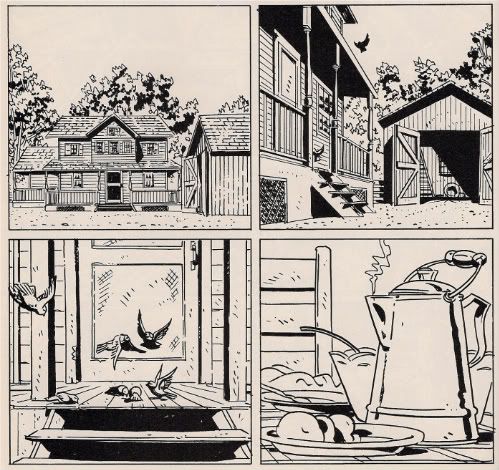 (From Different Ugliness, Different Madness)
(From Different Ugliness, Different Madness)
TS: I think my least favorites are probably obvious--I thought Olympus was just terrible, whereas I found that Transgenesis thing to be as near to unreadable as anything could be possible. That's to be expected though-I can't imagine anybody looking at the entirety of the Humanoids/DC line and loving everything in it--but those two just stood out in their complete lack of purpose or passion.
JM: We had different Transgeneses, and I didn't read yours - oddly, your review didn't prompt a burning desire for purchase! No, mine was just dull and obvious. El Niño all but put me to sleep too. But really, I didn't think any of these books were straight-up horrible. I didn't read all the books you did, so maybe I'd dislike those as much as you, but there's a real lack of total incompetence here, although I suppose Humanoids maybe knew not to let the really bad stuff get out. On the flip side, I should also say that I totally appreciate the efforts of 'literary' comics publishers in getting the presumed cream of the crop out there, and yeah, I don't think the DC/Humanoids line had its own David B.'s Epileptic, like a serious best-of-decade contender in terms of North American releases. Although I know some might slip the Nikopol Trilogy in there, actually.
But hey, let's not get too conclusive; we've got two guys left to read.
TS: I feel confident in my belief that Olympus was the worst piece of shit in the bunch. Prove me wrong, ligne claire!
II. Yves Chaland is Dead
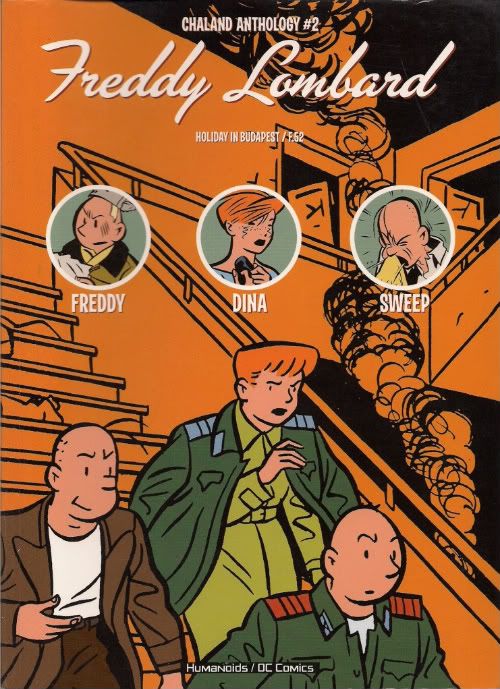
TS: Ah, the clean line, the "ligne claire"...how I recall the nights resting at my father's knee, "Tucker," he said to me, "Never forget the ligne claire, pioneered by Hergé in his many Tintin adventures."
JM: 'Ligne' and 'claire' were my third and fourth words as a child. 'Mama' placed tenth.
TS: So what were the first two? Miller and Mazzucchelli?
JM: Anyhow, Yves Chaland got a meaty two books dedicated to him in the DC/Humanoids adventure, the Chaland Anthology vols. 1 and 2. Book 1 covered three albums, 1981's The Will of Godfrey of Bouillon, 1984's The Elephant Graveyard and 1986's The Comet of Carthage. Book 2 sported two albums, 1988's Holiday in Budapest and 1990's F.52, the latter of which was published the year Chaland died in a vehicular accident. He was 33 years old.
TS: Why did you think Chaland was a "nostalgist bore"? I'll admit that I was mostly into him for the comedic value at first, although I was pretty sold on the look immediately. Correct me if I'm wrong: it was the comet story, right?
JM: The comet story (the third one) was what turned me around. It was the very first story, The Will of Godfrey of Bouillion, that put me off, in that I put the book away after reading it and didn't go back until you advised me to do so.
TS: Huh. I liked them both at first blush, but I'm a sucker for funny shit sometimes, and my relationship with the clean line was so limited at the time--they both worked for me pretty quickly. I don't know when else I'll get the chance to bring it up, so here's my favorite gags from The Will of Godfrey of Bouillion:
1: Freddy's Constant Scowling. Chaland always makes the guy go straight from normal to seething rage filled hate. He rarely follows through by vomiting acidic blood, but he always looks like he's on the verge.
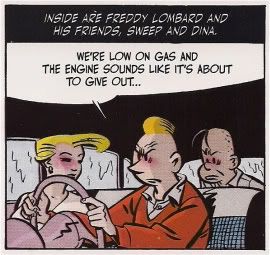
2. The dream sequence reminded me of when Moonlighting would do dream sequences, where all the actors would show up as various 20's era gangsters and what not. Best joke would be "Stop groaning Freddy! It's annoying!" coming from Sweep the bowman to Freddy's "I'm not groaning! Who are you, anyway?"
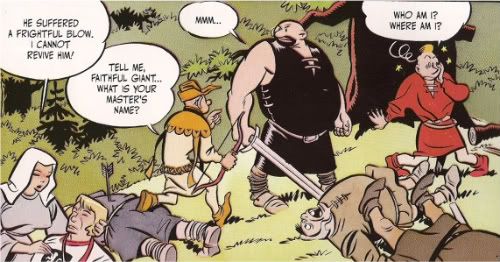
3. Drunk Freddy arguing with a statue about the weather. Kills me. Kills me stone dead.
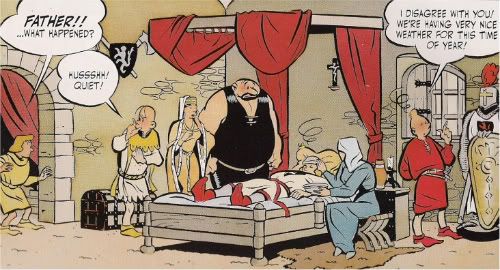
JM: Ah, I probably should have been more open-minded. Background, maybe? With me, the answer's always yes.
You see (you, reading this, not Tucker), the Chaland Anthology books were unique among DC/Humanoids projects in that they specifically set out to collect various and sundry short works by a single artist - one of the Bilal books, Memories, did that also, but that was only one book among various themed collections. Like I mentioned above, Humanoids put out a big oversized hardcover of the first volume in 2003, and then the DC deal had it reprinted as a standard-sized softcover, with a second volume following.
Those two books were the only ones released before the DC deal fell through, and they happened to collect all of Chaland's work with this character called Freddy Lombard, who was named for the old Belgian publisher Le Lombard, which published Tintin and The Smurfs and a lot of classic series; it was a statement of intent. There were two other Chaland Anthology books in France, and our most valued commentator Pedro Bouca -- and seriously, we've got to thank Pedro right now for giving us great feedback on every portion of this series -- tells us they contained some very strong material, really sharply satiric work criticizing the racist, paternalistic aspects of early Franco-Belgian comics by adopting their visual style and cranking up the ugly themes 1000x.
Which is something latent to Chaland's style, I've since come to realize. He'd been a cartoonist since 1978, with a lot of earlier fanzine work behind him, and he'd done some 'realistic' work, but he became famous as one of the guys who brought the ligne claire back into the public eye. Joost Swarte was also on that; he actually coined the term "ligne claire." But Chaland's take wasn't just emulation; it was called the "Atomic" style, a meaningful appropriation of an aesthetic charged with a specific social quality of its time, an idealism and sense of boyish adventure, which Chaland contrasted with particular, difficult subject matter to bring out some criticism or special evocation. Like, using the look of Tintin to poke at what went down when he visited the Congo.
TS: Oh, I love what I've seen of Joost Swarte. Is that cool? Does that make me lame? I don't care. Please continue.
JM: One day that big Swarte collection really will be released by Fantagraphics, and oh the birds will sing.
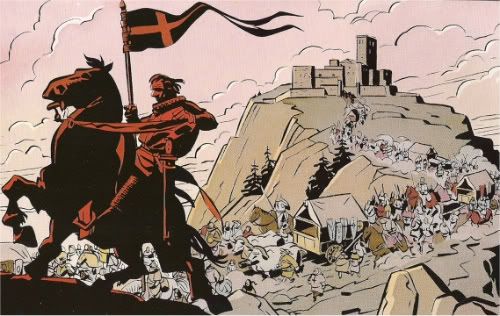
There's a lot of sheer visual pleasure to the stuff. Chaland became really popular, for illustrations as well as comics, if I recall correctly. But I wasn't so sure of that back when I read the first Freddy Lombard story in the first Chaland Anthology, which didn't contain any context or historical info or anything. It's just adventure guy Freddy Lombard and his crew -- bald, irritated Sweep and headstrong Dina -- getting mixed up in a search for treasure in the mountains, and then there's a really fucking long dream sequence set in a Peyo-like Dark Ages slapstick palace, and then the story kind of runs around.
TS: Goddamnit Joe, the guy gets drunk and argues with a statue about the weather. Let's not throw the baby out with the bath water. The water tastes of baby. That shit ain't freely available.
JM: The trick is, we're not told right away it was an experiment. It was like 'automatic drawing' for Chaland, a whole album he finished in 30 days, just blowing through a page a day until the story looked done, which naturally accounts for the extra-long dream. His head was full of old-timey comics! It just came out! But I didn't know that until the historical stuff included in the back of the Chaland Anthologies vol. 2; it just seemed misshapen as a story, really old-fashioned, almost winking slapstick. I didn't see any point, given the man's reputation, which I did know about, at least!
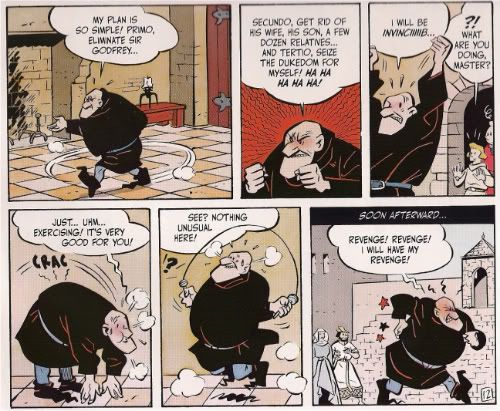
Here's something: do you think not having immediate context really hurts this stuff?
TS: I definitely came back to the story with a different mindset after reading about the "automatic drawing" stuff, but I wouldn't say it changed my initial enjoyment of the comics themselves. The backmatter, where Chaland describes the "automatic" proces made me respect the stories more from an experimentation aspect, if you know what I mean. I definitely responded to the artist behind the comics differently after I read that stuff though. Chaland... man, I really wish there was more of his stuff out there. Here he was, from his own notes: "I believe in treating the reader badly..." I wish that kind of honesty was more widely available. All the constant "let's talk to our fans" "I'm so glad you liked it" "I wish i could win an Eisner, aw shucks." Fucking Chaland had gigantic testes, full of man milk. They totally should have put that quote on the cover.
JM: DDP, are you reading? There's two of these things left! No pun intended.
TS: That kind of frank, open behavior--I don't know, maybe it's just me, but every time I ever read cartoonists mentioning the "lack of respect" comics get from high art types, I just wish they'd shut the fuck up. Chaland knew he was an artist, he didn't need somebody to argue it for him, or write a book about why it was true. He was an artist, he made art, and fuck you if you thought comics were for kids. It hurts that there's not more of him to read. Died too young, too soon.
JM: Right. I'd have probably had a different reaction myself if I'd actually read deeper into the first anthology. The second album in there, the Elephant Graveyard - that's a diptych of stories, one of which sees Freddy & co. (and one of the things I like is that they're total mooches, just hanging around wherever until adventure beckons) ship off to Africa at the behest of a wacky collector who really wants a rare photographic plate for his horde. Conflict against natives results, and we're assured that Our Heroes have brought utter chaos to a region that's been peaceful for a quarter of a century. The second story is much darker, concerning murders among white African explorers at home in Paris, with a connection to poaching and violence on the continent years back. You've mentioned having some problems with the material on first blush?
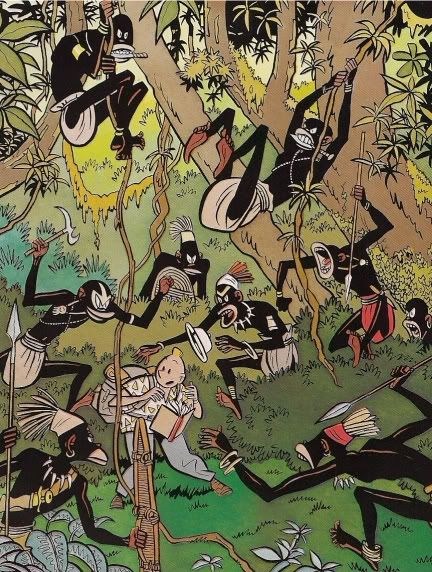
TS: Yes, his depiction of black people in the Elephant Graveyard story threw me off. It did then, and I had always skipped that stuff on the re-read until the team-up. So yes, Pedro Bouca, our comment resident expert on Humanoids: I will freely admit that I was one of those overly-sensitive American readers offended by the garish stereotype, because I didn't do any research. After finishing this re-read, talking a little bit with you, reading the back-matter and, for the first time, looking into the guys work, I found out that it was purposely done that way as satire.
JM: Uh huh; the two stories in the album sort of compliment one another, although they're both pretty critical; the first one casts all of this violence as a goofy, repugnant game between these dumb arch-collectors of nonsense, while the second refuses to even leave Paris while all these muscular French he-man explorers are murdered, despite that jaunty title: The Elephant Graveyard! Plus, Chaland wants the book to feel like an old Lombard production, so there's sincere laffs and shit, which probably jars even worse.
TS: The thing that I think hurts this a bit is that I came at this first volume--which doesn't have any backmatter, and the blurb description on the back doesn't indicate any of Chaland's intentions--as a non-blogging, non-wikipedia reading, non-googling type. I just bought this at a comic store and read it, and if I'd never joined the dark forces of "write shit on the Internet" club, I don't know when that feeling would have changed. One of the things I see as a consistent complaint online is that attitude that people shouldn't dislike something, or be offended by something, without getting the context. In some cases, I can agree with that--David Brothers put up a couple of panels from a Garth Ennis Hellblazer story once, the "Don't call me whitey, nigger" panels--and some people pointed to that as racist despite not knowing anything about the comic that surrounded that panel. There, I'm on the side of the publisher, the writer: read the comic first, don't make this into some Aryan maternity test. But in the case of Elephant Graveyard, I think that it's a strange choice to have a 134 page trade collection without any acknowledgement or mention that the reason the natives are big-lipped Booga Booga types is because Chaland was being ironic on purpose.
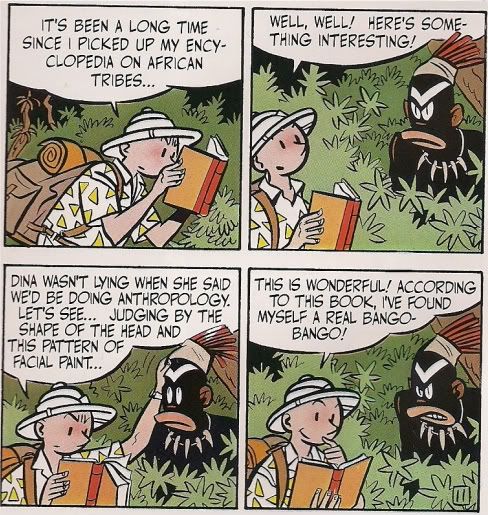
You mentioned the possibility that putting this alongside the first story was the "tell" that Elephant Graveyard wasn't supposed to be standard racist depiction done for racist reasons. And while yes, I'm more inclined to agree with you now, that isn't something that I think is explicit enough to be clear to the majority of the American audiences. If we were dealing with something like Tintin in the Congo or Robert Crumb's "Nigger Hearts," a comic that is easily surrounded by an existent discussion of the imagery, if we're talking about the Mamie character in the Walt & Skeezix reprints, were Chris Ware says "Look, we know how bad this looks, and we agree, it's kind of fucked up," that's one thing.
But these Yves Chaland reprints from DC/Humanoids? This isn't something that has a lot of peers for American readers, they barely got this stuff into bookstores, which means you're stuck with one potential audience: the direct market reader. I don't think it was the right choice to put this out there and just optimistically expect everybody would get it. A change in the back cover text--just the addition of the word "satire," maybe the type of disclaimer that Chris Ware puts in the front of those Walt & Skeezix books... shit, I don't like this anymore than anybody else does. It's veering pretty close to hand-holding, I know. But these aren't huge selling comics where they can just cockily write off the portion of the audience that would see those Booga Booga types and get upset. When you're dealing with these things, which I think Brian Hibbs once said got pre-orders of less than 5000, every potential buyer matters.
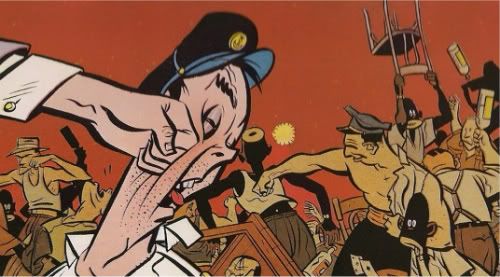
I don't know, I feel bad about making a big deal out of this, I didn't intend to. I love these two collections of Chaland's stuff, I really do. I don't have any evidence, anecdotal or otherwise, that American readers were upset by the drawings. I just want more of this stuff available, and I really hope the reason that there isn't is just because American readers suck at buying good comics, and not that some American readers were offended by what they saw here. Because this is one of the times when I think there wasn't enough context freely available for them to make an argument otherwise.
JM: Sure, I totally understand.
And then, after that - oh man, the comet one. The Comet of Carthage. That's the big leap, right there; it's where I should have kept reading until, because I know it would have knocked me on my ass.
TS: The Comet of Carthage--and I'll admit, I'm counting a bit on you to explicate this--it's just about a perfect comic. I have a lot of affection for all of the stories contained here, despite my P.C. concerns as well as finding the first story in the second collection, Holiday In Budapest, to be a bit long-winded. But I've got zero complaints with Comet Of Carthage, and when it comes to being disappointed at the loss of a guy who wasn't even 33 when he died, it's the fantasy of more stories like Comet that motivates that feeling.
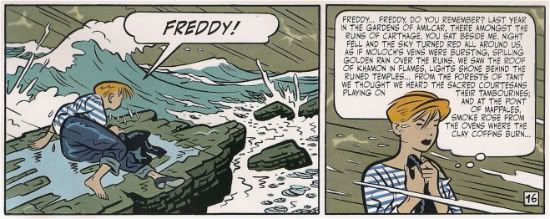
JM: How to describe it? I'm sure some of the shift in style comes from Chaland picking up a co-writer, Yann Lepennetier, who'd go on to work on every freddy Lombard story (so, three in total), but... it's like being slapped in the face. It's like Gilbert Hernandez stumbling on a lost Eddie Campbell Deadface script circa Doing the Islands With Bacchus -- I should mention right now that The Last of the Summer Wine, from the 1988 Harrier Bacchus series issue #2 is one of my favorite comic stories of all time -- and editing it in the smash-cut style of Love and Rockets at its most fevered. And, you know - Tintin references! Freddy Lombard 'n pals wandering around this unstuck-in-time place, a comet bearing down, scenes just barely connecting, mythological allusions everywhere, a mad professor in a submarine, a strange women in sunglasses - probably Nouvelle Vague too, actually. I loved this. LOVED it. The last page destroyed me.
It's funny, because none of it's 'realistic,' like even in the sense of evoking a '50s comic or anything. There's huge, huge word balloons and just... it somehow works? It's like an organic evolution of these comics into something that interacted with developments in French popular culture without shifting in pure surface aesthetic, like a crazy superfan's dream... does that make sense?
TS: Oh, I think I see where you're going with this. The timing of the whole thing, the way it delivers all the necessary tropes--the greasy scary guy with his mustache, the coming crisis of environmental destruction, the sultry seductress of mystery, the May-December romance--how it's all mashed up into one concise story? I'm terrible with France, my knowledge begins and ends with Godard and Ionesco. I think I have maybe two albums of popular French music, and both of them are terrible.
Those pages where "A princess" falls into the sea for Freddy to find her--I was knocked out by every little thing about it. The crash of the suitcase, the initial desperate grab for the picture of her and her sister, the why Chaland changed the direction of the rain to show how much worse the storm was getting, her scream of "NO" when the rocks started to fall...jesus, I'm not even looking at the comic, it's just nailed to my brain.
And yes, of course--the final pages of the comet coming down, even though we know it's not going to hit the Earth or something, the way it just punctuates this massive collapse, a tidal wave, an octopus...and then the sun comes up, and all that's left is wreckage.
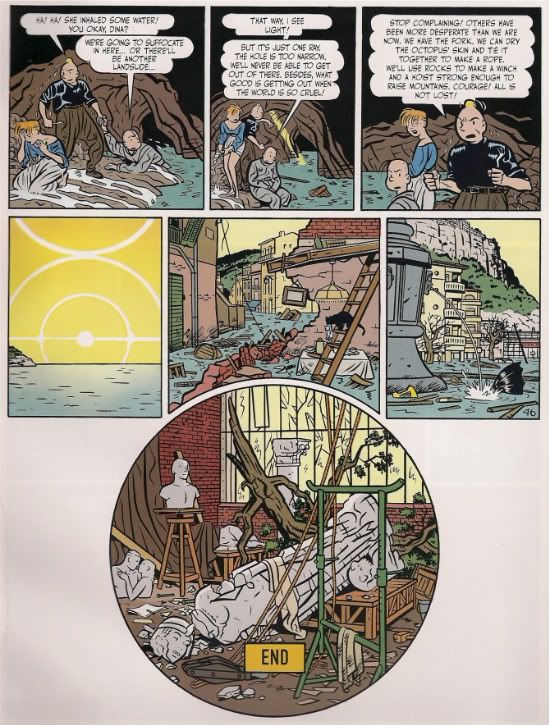
JM: Then we get to Holiday in Budapest (the start of the DC/Humanoids vol. 2), and, naturally, it's different once again. I think more than anything else in the series it fulfills maybe the 'expectations' for a project like this, in that it's a logical, 'mature' version of a 1950s Franco-Belgian comic, which Chaland mentions as his intent in the back - it's like a comic of the period, but tackling unrest in that part of the world, with the goofy heroes agreeing to take some kid back home to the city to be a man and fight the Russians, and antics totally goddamned ensue. It's not quite on-the-level, I don't think, in that I haven't read a ton of comics from that period (like most English-only Americans; my French is seriously as good as that of mold in an apartment in Paris), and there's some 'spicy' stuff I suppose, but I don't see a lot of irony to it. It's 'mature Tintin,' basically.
TS: Not to be too sarcastic, but I'd say you're right, and that's probably why I preferred F.52, no matter that it had a little mentally handicapped girl that everybody calls retarded. My favorite thing about Holiday In Budapest was watching Sweep get laid--the cutesy whining socialist and his misadventures wore me out. I just kept hoping somebody would stick a grenade in that kid's mouth. What an irritating little twat.
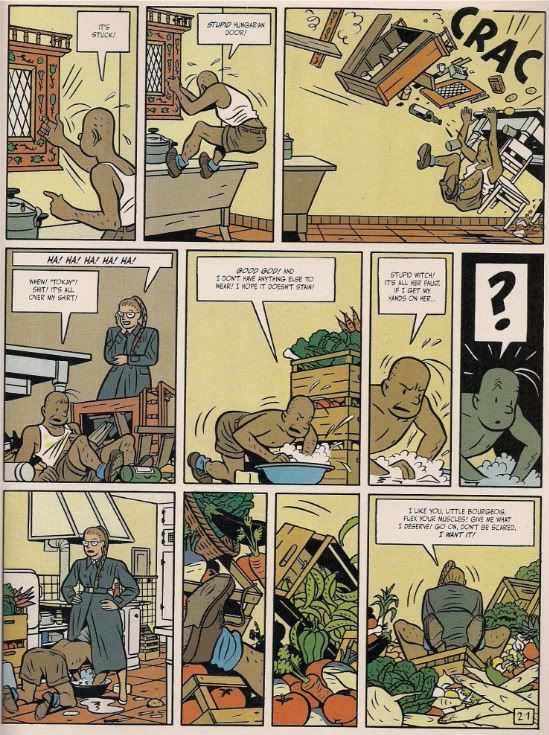
JM: Oh, the sex scene is totally the best part. I really dug how it's mostly this increasingly improbably series of slapstick antics that Sweep gets into, but you know, the essence of slapstick is physicality, and she just keeps watching his body going through these absurd routines and getting more and more excited - it's great.
TS: Definitely! If you read Holiday In Budapest and just skip anything with or about the kid, you end up reading this really great comic about Sweep and his asshole pal, Freddy Lombard.

JM: So what about F.52? It's a 'chaos on a plane' children in peril special, terror at however many thousands of feet, little girl running from crazy people in an enclosed space, with a tear-off-the-roof ending (not literally). I liked it when Freddy murders a woman and starts screaming NO! I DIDN'T MEAN TO DO THAT! or something, 'cause that's not supposed to happen! Much!
TS: F.52 doesn't have the same emotional punch to it that Comet did, but it's still pretty fucked up and insane. The violence in it is so brilliant--when the female part of the crazy couple beats the shit out of Dina, and the next time you see her there's just all kinds of gore hanging off her face--so amazing, and so out of nowhere. Or when the cabin crew brings the mentally handicapped girl back to the Jodie Foster stand-in (what was that movie called? Flightplan? Not Without My Daughter?) and she starts saying "This isn't my daughter" and then she fucking SHOVES the kid about 10 feet into a bunch of people? That's some pull-no-punches cruel comedy, it's like the Eastbound & Down of the ligne claire.
In some ways, I think F.52 wraps up Yves Chaland's Freddy work even better than Comet of Carthage. Now, I don't mean I like F.52 more, but I think this might be more of what he was going for with these Lombard adventures--clear antecedents in the "throw my characters in crazy circumstances to showcase what they do best" kind of plotting, the over-the-top, borderline juvenile humor, the somewhat obtuse addition of characters with weird motives and proclivities, and an overall tempo that just forces you to pump through the comic at whatever speed he dictates. On the other hand, Comet is a story that seems more direct and mature, a story that almost seems a little beyond the type of involvement Freddy and his pals provide. They seem--and this isn't so much a complaint or criticism--outclassed by the story surrounding them. In F.52, they couldn't be more at home: this is what they should be doing. Getting the holy fuck kicked out of them and accidently murdering people, all while wearing funny outfits.
JM: You've gotta wonder where he was going to take it from there. With this one he's adding graphic violence -- it's far and away the bloodiest of the Lombard stories -- to a sort of typical adventure setup. He mentions in the back that he liked the look of the aircraft. Very 'atomic,' which I'm sure sparked a lot of interest, although there was also a Tintin story set around a plane - Flight 714. They don't get on it until the end, though.
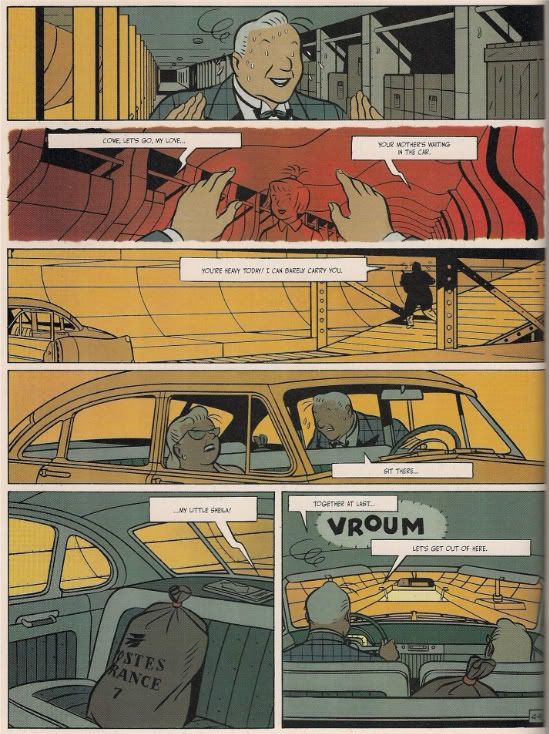
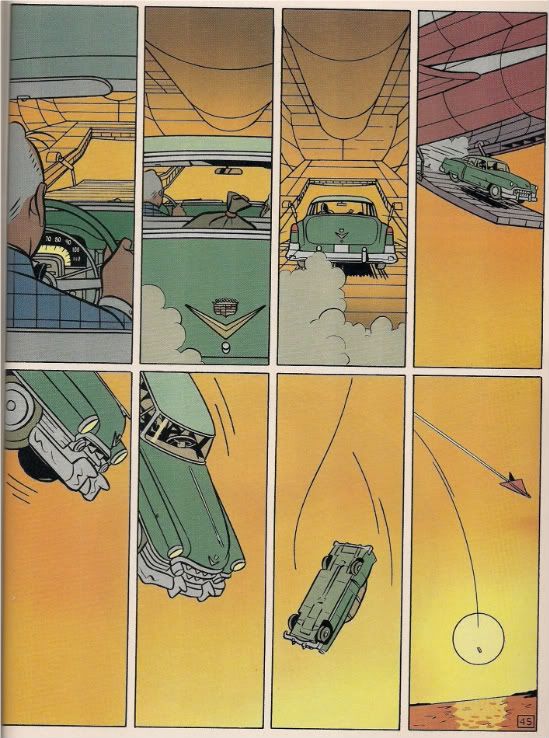
You're right; it's a good ending. The iconography of the final bit is powerful, and not just because of the circumstances surrounding Chaland's death that year (sadly, you can't escape that): nice vintage automobile, speeding into the air and falling gracefully into the sun. There goes the old style. There goes Yves Chaland.
III. Stanislas (Or the Decline and Fall of the '70s Avant-Garde)
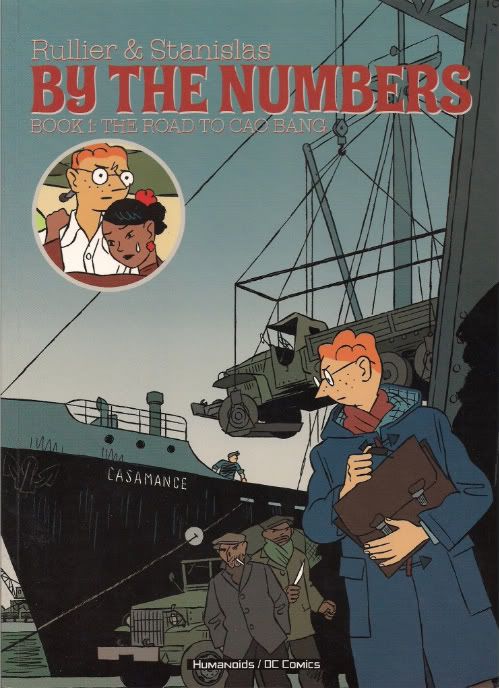
TS: I'm really curious to what you have to say about Stanislas & Rullier's By The Numbers, since I don't think that's one you and I have talked about at all the way we did about Chaland, Bilal, Jodorowsky. Without knowing in advance, i'll take a plunge and say that I liked this one as well, although I think it goes into different territory completely than Chaland does, despite it sharing a similar "look". For one, it's more direct in its ambition to be a comic about French people in Vietnam--I think there's even something in the end notes where the writer talks about how he wished there were more comics out there about the subject, but I didn't get a specific reason beyond that. He just wanted there to be comics set in that time period.
JM: It is a very straightforward historical adventure piece, isn't it?
For all you who may not know -- which is to say, possibly everyone besides Evan Dorkin -- By the Numbers is a series of books released between 1990 and 2004 by writer Laurent Rullier and artist 'Stanislas' (Barthélemy). There's actually only four of them, the first two of which were collected into the DC/Humanoids edition, although the supplements suggest there's probably been a number of revisions made to the material across various printings. As it is, the DC/Humanoids edition ends on a logical stopping point, although it's obvious the story isn't entirely over.
The books focus on this guy, Victor Levallois, who narrates the various stories from 1968, where he's a middle-aged balding guy with a lot of experience behind him. Most of the books are actually flashbacks that follow his life's path, from being a mild-mannered accountant in the late '40s to finding himself mixed up in money-making schemes in Saigon, and eventually falling in with a mixed crew of revolutionary opium smokers, not entirely ex-Nazis, action-starved volunteer French soldiers and a whole lot of grifters and rich kids who enjoy the notion of sex with 14-year old prostitutes. There's an apparently popular scheme going on at the time, exploiting legally-controlled exchange rates of currency, allowing for francs and dollars and piastre to get passed around for big French profits. Most of the dollars wind up going to anti-French forces in the area, but not a lot of folks seem to care - they're totally amoral in that regard, and Victor (an accountant!) comes to profit as well as the years go by. And he falls in 'love' with a young woman, of course, who's got a thing for gambling, and then the tides of history come in to wash it all away, etc. etc.
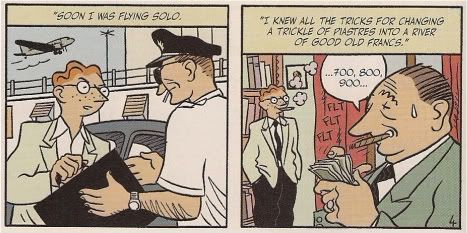
I was pretty startled by the depictions of morality in the book - I think that sets it apart as more 'novelistic' (oh god, there's a trap I've stepped into) than comics or movies or whatnot often art, in that there's a lot of nuance going on. Like, 14-year old prostitutes... that's fucking awful, there's all these terrible conclusions to draw from that, yet otherwise sympathetic characters are depicted as taking part of this type of vacation from morality. It's a real playground of paternal profit, as depicted, and the book really does an effective job of showing Victor's sort of conflicted delight in that world... he enjoys making money, Stanislas always draws him smoking that smart cigarette - what an ass!
TS: Yes, there's a definite paternalistic quality to this whole thing--while Victor doesn't behave atrociously or anything, and I'd imagine he's probably depicted a bit nicer than your standard "emigre with superiority complex," the entire relationship between him and his Vietnamese lover comes across as being a sort of "I look after you and your gambling problems, you dumb native chick, you'll love me whether you want to or not" kind of attitude. I'd bet there's some accuracy to that, romanticized as it might be.
JM: What did you make of Stanislas? His art? I think he added an extra layer of depth, in that he drafts all these rather unadorned 'just living' scenes without a lot of judgment as to the moral situation. There's the great bit early on with Victor carrying a little kid through a yard and into a house; it's not detailed art, but it's so lived-in, really evocative stuff without resorting to 'show your work' type of historical detail overload. It's really nice.
TS: It's interesting how the entire "feel" of the story's time and place were defined (to me at least) by those party sequences. Just a bunch of lazy French-types hanging around and drinking too much in some really precious attempts at beatnik lifestyle. It worked well when things start to get nasty, when they run out of money and the Vietnamese gangster types start turning against them. The portions on the ship, the shoot out at the dump--that stuff is all well and good, but I didn't get a sense that was specific to Vietnam or France. It was just a shoot out at a dump. But when you see those cocky pricks and their hammocks, with their stilted arguments about politics and their gross behavior towards the locals--that locked it into something out of The Quiet American.
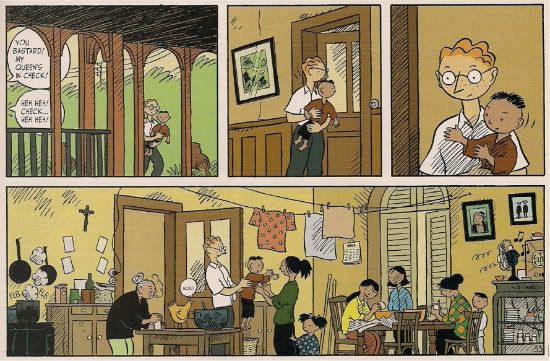
Stanislas doesn't seem to have the same blowing-up-the-spot kind of art that some of these cats do, although I think there's some moments of real excitement in By The Numbers. When I think about the collection--of which DC/Humanoids only released one, although the title "Volume 1" makes it seem like more was coming--the stuff that stood out the most for me was that war page in the second story, where most of the violence is shown through all red panels with the word "Bom" while black shadows shoot guns. Except for the "oops! sorry." dialog, there's just that one line at the end, "It lasted all night". That was a pretty tasty page.
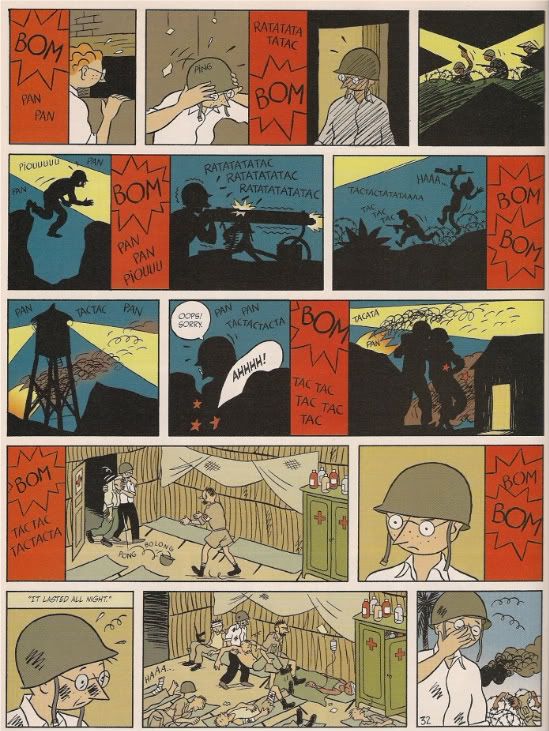
JM: He also manages to put together the occasional 'awesome' bit - the part at the end of chapter 1 with the fellow who's been sitting around (possibly all night!) with a gun trained on a guy's head - I liked the meshing of the story and art there, in that there's a sort of unassuming (and thus awful; frightening) 'no big deal' quality to guys getting shot.
TS: Oh, yeah, that part also had my favorite piece of dialog in the whole comic. Right before he shoots that guy, Mr. All Nighter says "I used to know an oberleutenant who got his throat slit by a 13-year-old girl!" That's the way he distracts him? It's such a random interjection. And then he shoots him from a seated position with a machine gun. Like you said, it's totally unassuming and awful--the guy just blows the dude to pieces from point blank range in the middle of the day. While sitting down. No negotiation, no "is there another way", he just kills him and leaves, so he can go to bed.
JM: Here's something - I tend to associate Stanislas' art more with, say, Dupuy and Berbérian and that kind of latter-day cartooning look, even though I suspect that the period setting of the series associates it with the clear line. What do you make of that?
TS: Oh, I'd definitely agree with the Dupuy/Berbérian connection. By The Numbers may be clear line, but it's a contemporary clear line. It's also almost universally a thinly lined comic, everything in here looks like it's not far removed from the type of layouts you see whenever a company publishes a cartoonists style. There's none of the type of brushed in depth you see in Chaland, where thick lines are added to Freddy's face to define his mood. By The Numbers is a really tightly boxed comic too, sort of the way Moebius laid out the Blueberry stuff I just read. Some of these pages have 20 panels, the only reason it doesn't smother the story is because they're all so clean to look at.
JM: Yeah. There's probably a bit less to talk about with a story like this in that it just sort of darts forward - I did think it kind of starts to lose impact once the shit really hits the fan by the end and Victor goes bananas trying to find his lover -- and period-psychological accuracy or not, I'll cop to never, ever being much of a fan of the old-school 'headstrong woman who dooms her man through his intense love and winds up a whore dying in agony, one presumes for her sins' character type; I do think the work buys into those genre (historical fiction genre) elements a bit -- where he's falling in and out of occasion in various locations, dodging death. I think the observational qualities got a bit lost there, even though there's still some skillful character bits. It's a very neatly composed work. Sure do wish we'd get the second half.
TS: The thing that I found interesting about his pursuit of the girl was that, whether it was intended or not, I never got the sense he loved her. Victor treated that girl like property, and his pursuit of her read like another version of Victor pursuing something that doesn't belong to him, but that he's laid claim too, the same way France treated Vietnam: we give a shit because we've decided we know better. Victor spends a good portion of the first volume chasing some money that doesn't belong to him so he can pretty much steal it himself, and then he spends the second half chasing a woman who he doesn't love so much as he believes she belongs to him. France in Indochina--they screwed around for a while and then America turned it into a blood-soaked debate on communism. Either way, it was white people just saying "We know better" to a bunch of natives. Victor, for all his qualities, isn't much different.
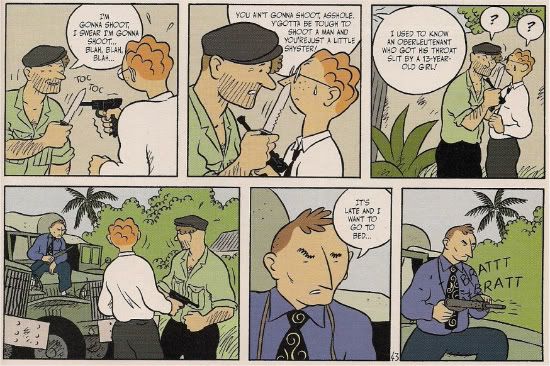
JM: There's more than one type of historical quality present too. The first of these books came out in 1990 - exactly the same year Stanislas co-founded the famous French alternative publisher L'Association with Jean-Christophe Menu, David B., Killoffer, Lewis Trondheim and Todd McFarlane. No, wait... Mattt Konture. And Mokeït, who stopped releasing work almost right after he started, thus forever branding him the Whilce Portacio of French comics. For me.
TS: Somebody should review every Wetworks related comic at some point. That would make for prime time reading.
JM: And it's funny, because L'Association wound up raising the banner of the avant-garde that Les Humanoïdes used to wave. That's totally a rough statement, granted - if anyone wants to learn more, I 100% recommend Bart Beaty's very fine book Unpopular Culture: Transforming the European Comic Book in the 1990s, which should fill you in on a lot of the stuff going on. But there's... I think Jodorowsky ruined my brain, because I'm thinking in such odd ways, but there's an odd symbolism to Humanoids releasing this work from the year L'Association opened, out into the midst of this broken effort to re-introduce the publisher's material to a North American audience, doomed to failure while it's the children of L'Association itself that finds such purchase, as far as the cultural perception of 'Eurocomics' goes. It's like their world, even though they're not 'mainstream' at all - the cultural capital is great, though. Maybe the exchange rate it better, like back in Indochina in the '40s.
IV. Howling Disaster
JM: Tucker, why do you think DC/Humanoids failed?
TS: Here's the thing: it isn't that the Humanoids Publishing empire is somehow better as a whole than any other publishing company.
JM: Gosh no; this is some alternate dimension shit, a 'real mainstream' apart from our reality.
TS: They put out crap, so does everybody else, and the lens for that crap is going to get focused even tighter by the basic stumbling block that the DC/Humanoids deal wasn't designed with any real aesthetic methodology behind it. DC picked the books they thought they could sell, they shoved them out on a ridiculous publishing schedule that was, regardless of who came up with it, indefensibly stupid, and they didn't back them up with any real marketing or ambition beyond turning to the internet for some token press releases--which the internet is already drowning in. They picked books that were demonstrably successful in other markets, including some that Humanoids had already brought to American market, they picked ones that were new and vaguely relatable to bookstore friendly graphic novels, but they did it in a haphazard, stupid fashion. What was Different Ugliness, Different Madness supposed to compete with in a comic book store? The Drawn & Quarterly and Fantagraphics books that those stores didn't carry or have an audience for? What was the point of re-releasing the Metabarons, the Nikopol Trilogy, White Lama, Sanctum and the Technopriests when the Humanoids versions of those titles had been released just a few years earlier and failed to crack the market? What was the point of a unified production design, one that matched the also-botched 2000 AD reprints, if the books were going to lack a unified content as well?
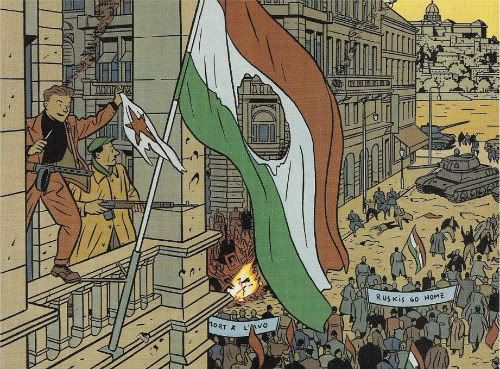
JM: Ha, the unified book design was almost all DC did in that regard; it took the million formats of the old Humanoids's Direct Market efforts and ordered them into a standard line. God rid of the blankets over the nudity too. And yeah, they had the Rebellion deal going on at the same time (somebody take this excessive reviewing baton and run!) - interesting on the similar format. Like all the foreign stuff goes in the same place, except for manga. Ah, but I'm sure they only wanted to make them easier to sort, or sell.
TS: Oh, I'd agree that it was a good bookstore choice, but it's also not something that can make magic happen. I like that MOME and the new Love and Rockets, House, Jessica Farm are all the same size, and I like that all my Humanoids are the same size, but come the fuck on: you can't just do that and some email bombing and call it a day. Grow the fuck up.
JM: I agree, I agree.
TS: It's one thing to publish a bunch of Humanoids reprints that focus on science fiction, which was the rough majority of DC's choices, and it's another to split the difference and throw in a black & white 30's 'feelings' comic, a short throwaway script Geoff Johns came up with in the weeks prior to when his DC-exclusive contract took effect, and a couple of compilation albums of satirical ligne claire work that looks like Tintin by way of chain smoking sarcasm. That's not a publishing imprint. That's vomiting books out, and it's no surprise at all that it couldn't crack a direct market--the store where I picked up many of these books on the release dates had no idea what or how many to order, they were completely dependent on the sort of people who read the monstrous Previews catalog, and while it's a debate I'm not wholly invested in, I do think the idea that the consumer should read through fucking Previews to find comics is completely fucking ridiculous.
DC/Humanoids, like DC and Marvel always seem to do, expected stores and consumers to trust them, to just order and order and order away, to just suck it up and build a new shelf for a bunch of comics a bare minimum of customers realistically knew existed. The intent was obvious enough--if DC could get the Tintin audience with Chaland, Rulliers & Stanisals, they'd have a foot in the door in a way that the adventures of Supergirl couldn't crack, if they could get the Palookaville and Alex Toth sketchbook audience with Different Madness, if their stand-alone science fiction sagas and epic Jodorwosky tales could do this, so on, so forth...the mentality was solid, that makes sense. The Humanoids books offered something that Vertigo and DC Universe titles didn't, still don't, and probably never will. (Unless something changes, I can't see Vertigo publishing stuff like Different Ugliness while Marvel MAX puts out the Metabarons, Soliel reprints notwithstanding.)
I think these things had a chance, and while I don't know if Devil's Due is the right home for them--I never know how much one should rely on that crazy Lying In The Gutters guy, but he's nailed that company for non-payment a few times--it's just ridiculous to me that something like Bilal, or Jodorowsky, comics that have huge exposure and name recognition amongst a swath of non-American readers besides Pedro Bouca. Tintin sells here: so could Chaland. Bad science fiction comics sell here: so could good science fiction comics. Huge epic kill-fest comics sell here: so could Metabarons.
I work in advertising, and I hate it when idiots just say that the solution is "marketing," so I won't just say that. But NOBODY EVEN TRIED with the DC run. They just chucked them out non-stop! It's not like there's a business decision that I can pick apart here, because DC didn't even come up with a business decision, beyond the actual format, which is honestly the only thing I think they got right. I can understand the criticisms against it from a purely comics-as-art standpoint, nobody wants to be forced into a specific size. But the Humanoids/DC line wasn't showing up with a huge amount of fanfare, and making some kind of "however the artists wants it" decision probably wouldn't have been the right call. (Bill Watterston didn't demand control over his Sunday pages in the first year of Calvin and Hobbes, he did that when he had the clout to pull it off.) Unified production design isn't the most attractive thing in the world, but if these books had made it to bookstores in a more expansive way, it would have made them more attractive.
But really, I'm just spitballing random opinionated specifics. If there was a business plan in place for DC/Humanoids, it was a completely mysterious "hope for osmosis and cold fusion" one. I can criticize what I think it was and brainstorm rough drafts of what I think it should have been, but the simple truth is that they didn't try anything at all beyond the physical printing of material. So here's the simple answer, which I should have put before all these paragraphs: They didn't do anything. They should have tried something.
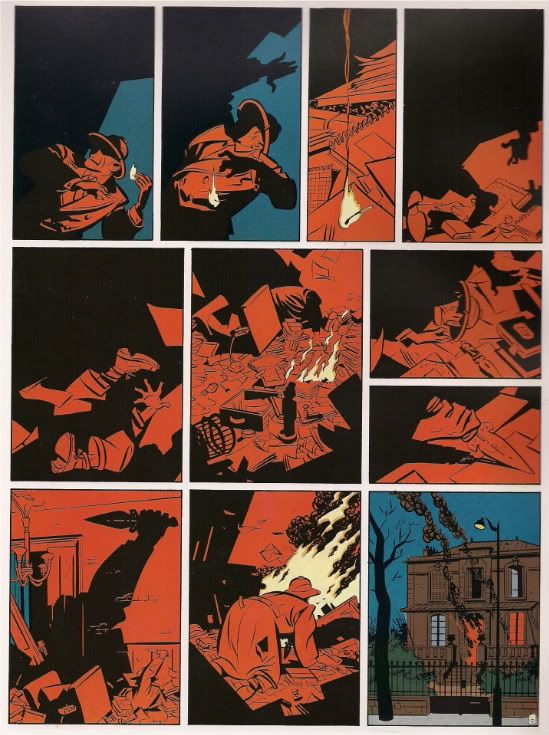
JM: That's very well put. When I look at these things, I'm really taken with the futility of struggling against history. Because the last time Humanoïdes found themselves introduced to the North American comics audience, there also didn't seem to be much of a plan besides trusting the National Lampoon people with making a nice magazine -- and if you look at some of Jean-Pierre Dionnet's comments, some of them felt their trust was misplaced, in an aesthetic sense -- which, if you really look at those early issues, turned out to be some ferociously newcomer-unfriendly shit! There'd be whole issues composed of nothing but middle chapters of serials and pin-ups, there was no fucking context or artists' statements or recaps or anything, just 'look at all this cool shit, it's great!' and there really was a positive reaction. Yeah! That is great!
It was a different time. Print magazines were still a solid concern; National Lampoon was very popular. American comics and comics readers were really hospitable to that kind of work. The maturation of the form seemed to match up at that moment, in the US and France, which is funny, since France & Belgium used to lag behind a bit in the '50s compared to the US and Japan - I bet if we ever see a lot of examples of the gekiga Yoshihiro Tatsumi works on in A Drifting Life, it wouldn't be a thousand miles off from the baby steps taken by Charles Biro's crime comics. But Japan made a choice to keep going forward, and the US found itself acting differently, from political, social pressure - many factors. Heavy Metal was witness to a new instant of international union, dramatic as that sounds. Odd things came in; they always do at those times.
There'll be more times like that, although who knows what it'll involve. Certainly that wasn't the case with Humanoids, with or without DC. They contorted, cut, capered and cried for access, and they got it - too much. What barking madness, eh?
TS: The best thing that can be said about DC's failure, the way I see it, is that I don't think anybody with any sense would see what they did and use that as evidence that there's no audience for what guys like Bilal, Yves Chaland or Alejandro Jodorowsky have to offer. These things may have sold miserably--by all accounts, that seems to be true--but it seems just as obvious that was more because anything would fail when presented with this little intent and design. One of the things you touched on in your own review of Bilal's The Beast Trilogy was that he was an artist who regularly sees another "push" to get him over here. You go on Amazon right now, or eBay, you find people offering and selling copies of his work for insane prices--these guys aren't going anywhere.
And the thing is, as much as I want the artists I like to succeed while still alive enough to enjoy it, some of these guys won't feel it until they, like Tatsumi, hit 70, and some of them won't hit it until after they're dead. They didn't all make books that have those kind of legs, but some of them did, and I want to believe that the good will out, and that someday down the line you won't have to bust your ass and break into your savings just to find out how great The Woman Trap is.
JM: These artists, though - maybe their fame right now is all they want. The North American comics industry can pretend that where it goes follows the world, but honestly? I don't think many people do that anymore. I think most of us that know these names know of the respect that a lot of them already have; what's ours but icing? Gravy? Brown icing? Another revenue stream? Another 10,000 copies sold, atop Bilal's 400,000? Jodorowsky didn't sound like he needed sound like he needed attention from our neck of the woods on Newsarama.
But yeah, what about the discovery? For North American readers, English-only? It's hard to even talk about some of these books, given that some of them have already become so rare and costly; speaking of lessons learned on this trip!
It's not over. Humanoids is still around. Cracks are still visible in the taped-over window. Comics are better and worse than they were half a decade ago. And something's gonna happen again. We don't need another five years to tell you that.
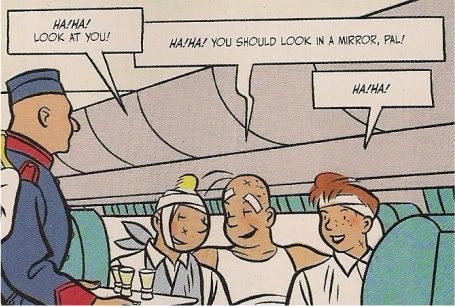
![]()
